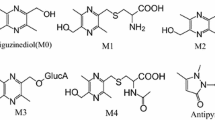Summary
A high-performance liquid chromatography with ultraviolet detection method was established and validated for quantification of forsythoside concentrations in dog plasma. Following a single-step protein precipitation with perchloric acid, the forsythoside and internal standard were separated on a reversed-phase C18 column with water-glacial acetic acid-methanol as mobile phase at a flow rate of 1 mL/min with ultraviolet detection at 326 and 278 nm for forsythoside and IS, respectively. The calibration curve for forsythoside was linear over a range of 0.052–13.33 μg/mL with correlation coefficient of 0.999. The within- and between-batch precisions of analysis were <8 % and accuracy was 95–107%. After intravenous administration of forsythoside at the doses of 5, 10, and 20 mg/kg, theC max values for forsythoside were estimated to be of 12.33, 22.90 and 54.45 μg/mL, respectively. The AUC increased with the increasing of doses, and the mean AUC0-t values were 5.69, 11.80, and 18.66 mg·h/L, respectively. Forsythoside was eliminated quickly and the meanT m values at doses of 5, 10, and 20 mg/kg were 1.36, 1.49, and 0.71h, respectively. The pharmacokinetics of forsythoside in beagle dogs complied with linear kinetic course in the dose range.
Similar content being viewed by others
References
Zhang L.W., Liu J., Yang P. (2003): Study on the Antioxidant Activity of the Chinese Herb Forsythia Suspensa Extract. Food Sci., 24, 122–125.
Duan F., Zhang S.M., Yang J.X., Li F.R. (2005): Studies on the anti-bacteria effect of extracts from Folium Forsythia in vitro. Northwest Pharm. J., 2, 66–67.
Zhang H.Y. (2000): Advances in studies on chemical constituents and pharmacological activities of Jasminum. J. Chin. Med. Mater., 23, 657–660.
Wang H.J., Jiang H., Wu G.J. (2005): The Study of Forsythoside in antibacterium in vitro and in vivo. China Feed. 10:26–27.
Hu K.J., Xu K.J., Wang Y.H., Sun K.X., Wang D. (2001): The Study of Forsythoside in antivirial in vitro. Chin. J. Technol. Tradit. Med., 8, 89.
Feng S.Y., Li X.R. (2006): The Study of Forsythoside in Anti-infection and Abatement of Fever. Mod. Biomed. Progr.. 6, 73–75.
Li Y.X., Jiang X.H., Liang H.Y., Li X. (2008): Determination of forsythiaside in rat plasma by high-performance liquid chromatography and its application to pharmacokinetic studies. Biomed. Chromatogr., 22, 361–366.
Xuan X.L., Shi Y.G. (2006): Test of the Extraction and TLC Determination of the Forsythia suspense Thunb. J Anhui Agric Sci., 6, 1114–1116.
Zhao W.H., Shi R.B., Liu B. Zhang L.Z. (2005): Determination of phillyrin and forsythoside A in Lianqiao Bingdu Qing capsule by RP-HPLC. China J. Mater Med., 30, 39–43.
Zhang L.W., Yang P. (2003): Study on the stability of forsythiaside. Chin. Tradit. Pat. Med., 25, 353–356.
Author information
Authors and Affiliations
Rights and permissions
About this article
Cite this article
Shi, R., Xuan, Z., Ma, Y. et al. Pharmacokinetics of forsythoside after intravenous administration in beagle dogs. Eur. J. Drug Metabol. Pharmacokinet. 34, 101–105 (2009). https://doi.org/10.1007/BF03191158
Received:
Issue Date:
DOI: https://doi.org/10.1007/BF03191158




